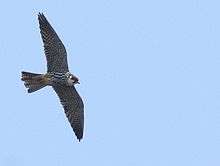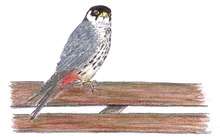Eurasian hobby
| Eurasian hobby | |
|---|---|
 | |
| Scientific classification | |
| Kingdom: | Animalia |
| Phylum: | Chordata |
| Class: | Aves |
| Order: | Falconiformes |
| Family: | Falconidae |
| Genus: | Falco |
| Species: | F. subbuteo |
| Binomial name | |
| Falco subbuteo Linnaeus, 1758 | |
The Eurasian hobby (Falco subbuteo), or just simply hobby, is a small slim falcon. It belongs to a rather close-knit group of similar falcons often considered a subgenus Hypotriorchis.[2][3][4]
Taxonomy and systematics
The first formal description of the Eurasian hobby was by the Swedish naturalist Carl Linnaeus in 1758 in the tenth edition of his Systema Naturae under the present binomial name Falco subbuteo.[5] The genus name falco derives from Late Latin falx, falcis, a sickle, referring to the claws of the bird.[6] The species name subbuteo is from Latin sub, "near to" and buteo, " buzzard" .[7] The species' English name comes from Old French hobé or hobet.[8] It became the trademark for the Subbuteo games company after its creator was refused permission to register "Hobby".[9]
Currently two subspecies are recognized:
- F. s. subbuteo: the nominate race is resident in Africa, Europe and Central and East Asia, winters in Central and South Africa and South Asia
- F. s. streichi: described by Hartert and Neumann in 1907, is smaller in size and is found further east of F. s. subbuteo's distribution range
Description
Adults are slate-grey above with a dark crown and two short black moustachial stripes. The throat is unstreaked white, thighs and undertail coverts are unstreaked rufous and rest of the underparts are whitish with black streaks. Close views enable the red "trousers" and vent to be seen. Sexes are similar. Juveniles are generally much browner, with scaled upper parts and streaked buffy thighs and undertail coverts.[10]
The hobby has a distinct first-summer plumage.[11]
This falcon is 29–36 cm (11–14 in) in length with a wingspan of 74–84 cm (29–33 in) and a weight of 175–285 g (6.2–10.1 oz).[12]
 F. subbuteo from Kadzidlowo
F. subbuteo from Kadzidlowo.jpg) Juvenile F. subbuteo portrait
Juvenile F. subbuteo portrait In flight
In flight
Distribution and status
This species breeds across Africa, Europe and Asia. It is a long-distance migrant, wintering in Africa and Asia.
Behaviour and ecology

It is a bird of open country such as farmland, marshes, taiga and savannah. They are widespread in lowlands with scattered small woods. It is an elegant bird of prey, appearing sickle-like in flight with its long pointed wings and square tail, often resembling a swift when gliding with folded wings. It flies powerfully and fast. It will take large insects, such as dragonflies, which it transfers from talons to beak and eats while soaring slowly in circles.[13] It also captures small bats[14] and small birds like swallows, swifts, pipits etc. in flight. Its speed and aerobatic skills enable it to take swallows and even swifts on the wing, and barn swallows or house martins have a characteristic "hobby" alarm call. It is known to harass swallows while they are roosting and dispersing from roosts.[10] When not breeding, it is crepuscular, hawking principally in the mornings and evenings. While on migration, they may move in small groups.
Hobbies nest in old nests of crows and other birds. The tree selected is most often one in a hedge or on the extreme edge of a spinney, whence the bird can observe intruders from a considerable distance. It lays 2–4 eggs. Incubation is said to take 28 days and both parents share in this duty, though the female does the greater part.[15]
It is a very bold and courageous bird and was used in falconry, trained to hawk birds like quails, larks, hoopoes, drongos, etc.[16]
References
- ↑ BirdLife International (2013). "Falco subbuteo". IUCN Red List of Threatened Species. Version 2013.2. International Union for Conservation of Nature. Retrieved 26 November 2013.
- ↑ Helbig, A.J.; Seibold, I.; Bednarek, W.; Brüning, H.; Gaucher, P.; Ristow, D.; Scharlau, W.; Schmidl, D.; Wink, Michael (1994). Meyburg, B.-U.; Chancellor, R.D., eds. Phylogenetic relationships among falcon species (genus Falco) according to DNA sequence variation of the cytochrome b gene (PDF). Raptor conservation today. pp. 593–599.
- ↑ Wink, Michael; Seibold, I.; Lotfikhah, F.; Bednarek, W. (1998). Chancellor, R.D.; Meyburg, B.-U.; Ferrero, J.J., eds. Molecular systematics of holarctic raptors (Order Falconiformes) (PDF). Holarctic Birds of Prey. Adenex & WWGBP. pp. 29–48.
- ↑ Nittinger, F.; Haring, E.; Pinsker, W.; Wink, Michael; Gamauf, A. (2005). "Out of Africa? Phylogenetic relationships between Falco biarmicus and other hierofalcons (Aves Falconidae)" (PDF). Journal of Zoological Systematics and Evolutionary Research. 43 (4): 321–331. doi:10.1111/j.1439-0469.2005.00326.x.
- ↑ Linnaeus, C. (1758). Systema naturae per regna tria naturae, secundum classes, ordines, genera, species, cum characteribus, differentiis, synonymis, locis. Tomus I. Editio decima, reformata (in Latin). holmiae (Stockholm): Laurentii Salvii. p. 89.
F. cera pedibusque flavis, dorso fusco, nucha alba abdomine pallido maculis oblongis fuseis.
- ↑ Shorter Oxford English dictionary. Oxford: Oxford University Press. 2007. p. 3804. ISBN 0199206872.
- ↑ Jobling, James A (2010). The Helm Dictionary of Scientific Bird Names. London: Christopher Helm. pp. 266, 369. ISBN 978-1-4081-2501-4.
- ↑ "Hobby". Oxford English Dictionary (3rd ed.). Oxford University Press. September 2005. (Subscription or UK public library membership required.)
- ↑ Hodkinson, Mark. Table-topping star of the big flick-off: Uncovering the bizarre playboy lifestyle of Subbuteo’s inventor. The Times, 16 October 2006. Retrieved on 2007-08-12.
- 1 2 Rasmussen, P.C.; Anderton, J.C. (2005). Birds of South Asia: The Ripley Guide. Volume 2. Smithsonian Institution & Lynx Edicions. pp. 114–115. ISBN 978-8496553859.
- ↑ small, Brian (1992). "First-summer Hobbies in the New forest" (PDF). British Birds. 85 (5): 251–255.
- ↑ Jais, Markus. "Eurasian hobby, Falco subbuteo". European Raptors: Biology and Conservation. External link in
|website=(help) - ↑ Butler, E.A. (1875). "Notes on the Avifauna of Mount Aboo and northern Guzerat". Stray feathers. 3: 443–444.
- ↑ Mikula, P.; Morelli, F.; Lučan, R. K.; Jones, D. N.; Tryjanowski, P. (2016). "Bats as prey of diurnal birds: a global perspective". Mammal Review. doi:10.1111/mam.12060.
- ↑ Baker, E.C.S. (1928). Fauna of British India. Birds. Volume 5 (2nd ed.). London: Taylor and Francis. pp. 41–45.
- ↑ Jerdon, T.C. (1864). The birds of India. Volume 1. George Wyman and Co, Calcutta. pp. 34–35.
External links
| Wikimedia Commons has media related to Falco subbuteo. |
| Wikispecies has information related to: Falco subbuteo |
- Eurasian Hobby or Hobby Falcon species text in The Atlas of Southern African Birds
- Ageing and sexing (PDF; 5.7 MB) by Javier Blasco-Zumeta & Gerd-Michael Heinze
- Audio recordings of Eurasian hobby on Xeno-canto.
- "Eurasian hobby media". Internet Bird Collection.
- BirdLife species factsheet for Falco subbuteo
- "Eurasian hobby". Avibase.

- Eurasian hobby photo gallery at VIREO (Drexel University)
- Interactive range map of Falco subbuteo at IUCN Red List maps
